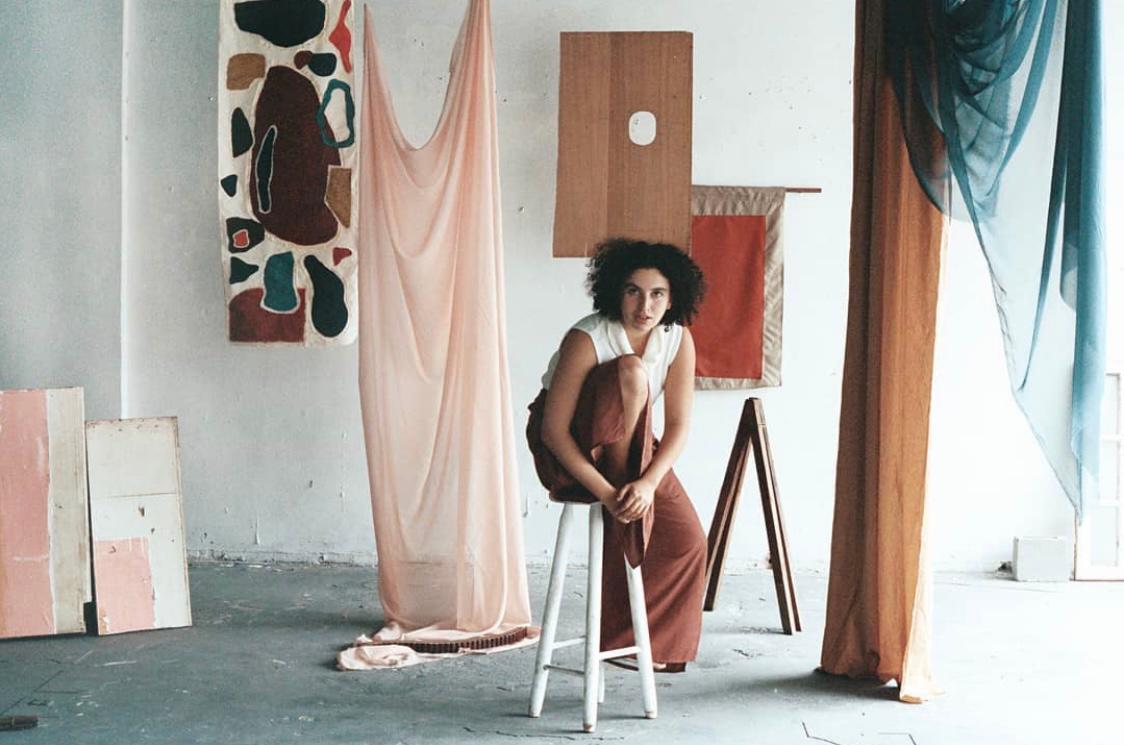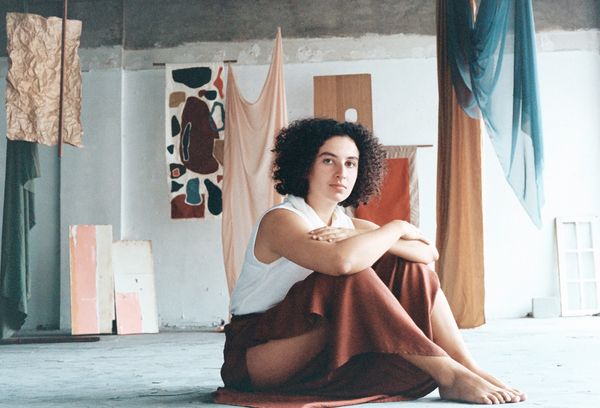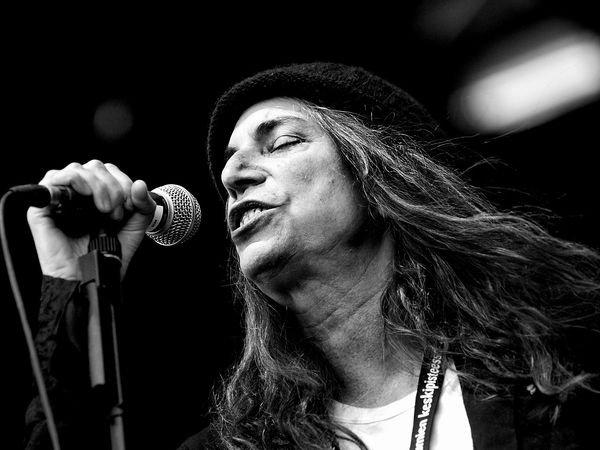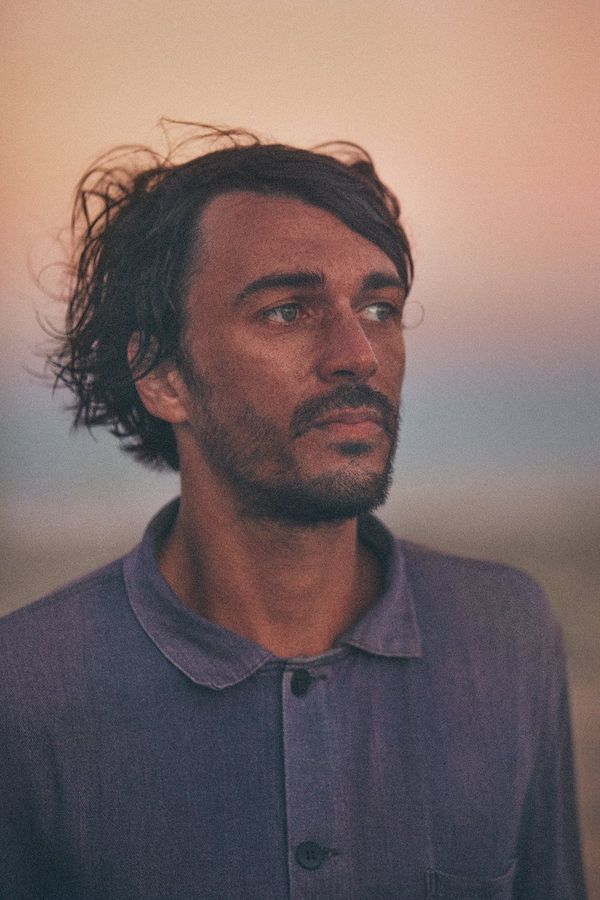by Rapha Grumser
The title of Dora Morelenbaum’s debut EP, Vento de Beirada, is a phrase that translates literally to “edge wind” or “wind from the edge.” A devoted fan of Morelenbaum’s told me that for him, the phrase evokes standing at the edge of a cliff that hangs above a vast sea. Peering downwards into the blue expanse below, you feel a warm wind begin to blow. The gust of wind either knocks you backwards or envelops you, emboldening you to plunge into the depths.
Morelenbaum, now in her mid-20’s, casts old friends and new collaborators as players and producers on Vento de Beirada. Her approach to making music is collaborative and community-oriented—finding useful models in groups like Novos Baianos and records like Tropicália ou Panis et Circencis. Growing up in a profoundly musical family, she is no stranger to the tradition of Brazilian popular song. (Her parents, Jaques and Paula Morelenbaum were integral members of Tom Jobim’s band, among many other notable projects.) She is steeped in the música popular brasileira tradition but bent on pushing it to mysterious new places.
Without fear of wind or vertigo, Dora Morelenbaum dives into her first EP. We spoke (in Portuguese, translated below) about Vento de Beirada, her vast net of creative partnerships, re-discovering Di Melo, and our mutual love for Clarice Lispector.
RAPHA: This morning I was transcribing a bit of “Vento de Beirada.” It’s funny: In the blurb I wrote a few weeks ago about it, I kept seeing threes in the composition. And only now, as I sat down to learn it, did I realize that the harmonic modulation before the bass clarinet solo goes up a minor third.
DORA: [Laughs] Yes. Awesome. You can go pretty far with that. If you were to look for threes in the rhythm of the words, you might be able to find even more threes. I had already noticed that, superficially. I won’t tell you it’s a coincidence, but maybe a fortuitous occurrence, that this number kept appearing in the song. In the blurb, I loved that you talked about Clarice Lispector. She’s connected to a certain kind of existentialism present in the lyrics of “Vento de Beirada.”
Did you have something specific in mind with the lyrics?
It’s the only song on the EP that is not mine. It was composed by Zé Ibarra, Lucas Nunes, and Victor Vasconcellos. The words are Victor and Zé’s, and I don’t know if there was some specific text that inspired them. Originally, it didn’t have the name “Vento de Beirada.” When I was working out the universe of the EP, Zé gave it that name because of this sensation of surrender, of diving into something, that the lyrics talk about.
What was the recording process like?
Originally I wanted to record new songs composed by my friends, including “Vento de Beirada.” I had a few songs of my own but I didn’t recognize them as ready to record yet. It was only when I began to face my own songs, so to speak, and imagine possible directions for them, that I began recording. “Japão” and “Avermelhar” came at the same time, and they both had this feeling of the start of something—the beginning of my first songs, you know? They worked well with the whole idea behind the phrase “vento de beirada,” which is a surrender, a leap of faith, or first step that is recording a debut EP.
I began recording these three songs at the end of 2018, beginning of 2019. Initially, I wanted the project to have more songs by my friends and partners. It ended up being only one song written by other people and two songs of my own, but the collaborative aspect was still important to me, so I invited my friends to participate in the process. I called Lucas Nunes, Ana Frango Elétrico, and Guilherme Lírico to produce it with me. Ana Frango and Guilherme were already my friends, but we became a lot closer working together.
Why did some earlier material like “Dó a Dó” not make it onto the EP?
I composed “Dó a Dó” with Tom [Veloso] while I was recording the EP. We both felt that “Dó a Dó” lived on a different musical planet—it had a lot more of that classic song format; it was rounder, both in terms of harmony and form. I saw another direction for it: a more conventional one that didn’t really have much to do with what I was building on Vento de Beirada, which has more to do with a kind of unfolding or expansion to musical places that are more mysterious.
In this whole process I didn’t want to deal with my own songs, my compositions. But in the end I faced two of them. And I finally grouped together more songs that I’d like to work on, to give them color and create arrangements for them. So these are some of the songs that I’m currently working on, which are part of a project of my own originals that I want to do—but it’s still pretty incipient, embryonic.
Could you talk more about this new project?
Well, it’s still a bit of a secret [laughs].
Working with others seems to be an integral part of your process. I watched your show on Festival Levada with Zé Ibarra, Lucas Nunes and Julia Mestre. You guys performed some new songs, like “Essa Confusão.” Could you speak about what collaboration means to you?
I feel like my generation, and the one that is slightly older, is capable of doing everything by themselves. It’s possible to record an entire album alone: You can record all the instruments, sing everything, mix it yourself, do the album art yourself, distribute it yourself, et cetera. It’s something that is possible, but I find it a lot more fun to throw other personalities into the mix. It can be interesting if you do it all yourself, and there are certain artists that really make it work. But I think it’s a lot more pleasurable if it’s not a totally solitary process. I like it when, for example, I see album artwork that has a strong mark of the designer who made it, or when you invite a musician to work on your project and give them plenty of space to do their thing.
The four of us—Zé, Julia, Lucas and I—have collaborated for a long time. We met back in grade school and have always played together. That’s why we’re always working on each other’s projects. And we’re planning on starting something that comes out of this desire that we have to expand our creative partnership outward.
The four of you have wonderful vocal quartet arrangements, but you are distinct as a soloist on the new EP. Do you see a clear division between these different modes of singing and working? Do you think differently when you are singing in a quartet and when you are doing your solo material?
We do a lot of vocal harmonies because it’s a delicious thing to do. I used to love singing in choir when I was in grade school, and I would always bring that passion when I played with them. We all love harmonies. Lucas and Zé, for example, are like the biggest of fans of Take 6 on the planet [laughs]. We like harmonizing so much that sometimes we try to do it where it doesn’t quite fit. But I don’t think I separate much between the two. We’ve talked a lot about this harmonic approach and how present it should be on our recording projects. We have a tendency to want to sing everything together, but in reality it can be more interesting when we alternate voices, when it’s possible to distinguish between different timbres; playing with the differences between the female voices and male voices, mixing those up. It’s a delightful thing to play around with, this study in timbres and vocal textures.

I wanted to talk a bit about your cover of Di Melo’s song, “João.” I loved your arrangement of it—so different from the original.
I’d been aware of that Di Melo record for a while but I wasn’t familiar with the whole album. I don’t know if you know this, but Di Melo made that debut record in 1975 and then disappeared from the Brazilian scene. He got some radio play at the time, but not a lot, and then didn’t follow up with other albums. He was rediscovered by beatmakers—in the US, I think—that started sampling a lot of Brazilian music from the 1970’s, records by people like Arthur Verocai. So then there was a newfound interest in Di Melo’s music because of electronic music, and a lot of the people who know and listen to him now are young people. I knew some of his more upbeat cuts from the album, but when I sat down and really listened to the whole thing I noticed that there was this kind of Banda Black Rio thing to it:—kind of samba music, but also kind of soul music.
The song “João” was originally a very slow samba, almost a bossa. When I first heard it I was struck by the lyrics that talk about this João—which is an extremely common name, it could be anybody—who pretends to be someone he is not; who puts on the mask of a king, but inside is totally broken and questions everything, just like everyone else. At a certain point in the song, Di Melo talks about the guy who can be found hanging around the bars, who puts on a persona. It’s a stock character here in Rio, and when I heard the song, it gave me a certain longing for the bar scene, the boteco.
In my version, I wanted to evoke the nocturnal João, the João of the bars, the one who is always telling stories and putting on a show for other people. So I wanted to do a slower, more nighttime arrangement that’s about this João that suffers in the mystery of the night. I called Lucas and Zé and Felipe Moura to play on the track. We recorded everything live. The final vocal on the track was actually the first take of the guide vocal I did. I was going to re-record a new vocal on it, but then I thought that the first take was so sincere and had so much to do with this kind of casualness of the street. I’m happy with how it turned out, and I think I saw a lot of this nocturnal João in the final recording.
A lot of artists have returned to old classics during the quarantine, revisiting favorite albums from their youth and finding new things in them. What have you been listening to lately?
That happened to me too! I went back to a lot of my favorites, but also discovered old recordings I had never paid much attention to, like [Maria] Bethânia’s Drama. Even this album by Di Melo was something that I discovered during the quarantine. Also, I re-discovered Jorge Ben’s A Tábua De Esmeralda. I went back to listening to some things by Erasmo Carlos that I had never given a proper listen. But I also listened to a lot of music that my friends were releasing: a lot of things by Ana Frango; also Tim Bernardes, who is from São Paulo and is a super-composer who I adore. Antonio Neves, an incredible instrumentalist from Rio who plays with Ana Frango, just released a great record of instrumental music with a bunch of guest features. It’s very well made and very well produced.
You grew up in a very musical family. What was your musical childhood like? Did you always know you wanted to pursue a career in music?
Singing is something I’ve always done, and it’s always been a big part of my language. It’s something that is extremely natural to me. My first music teachers were my grandmother and my aunt. [Music] has always been something so extremely natural that I never thought of it as a serious professional possibility. When I graduated from high school, I didn’t go to music school; I studied architecture for two years instead. But when I saw that my peers were beginning architectural internships, I realized “Wait, I actually don’t want to do this for a living.” That was when I began to consider music more seriously and not with this spontaneous, natural approach. Then came the thoughts: How am I going to make this work? What is my place in the world of professional music? The “aha” moment came through my own composing. I’ve always wanted to sing, to record songs written by my friends, maybe, but none of that really motivated me to get to work. It was only when I began to compose seriously, when I began to see my own compositions as something that could be developed, that I thought “this is what I really want to do.”
Could you talk about your composition process?
I don’t have a specific method. As I mentioned earlier, I really enjoy collaborating with others. Songs that are borne out of partnerships are less of a struggle because you can write one part and send it off to another person. Then it’s no longer entirely in your control; it’s in another’s hands. Sometimes you send something off and you get back a finished piece—it’s lovely when that happens—but there are some songs that you just have to struggle with. I usually start with the music and then move to writing lyrics, or send it off so that someone else can write the lyrics. I’ve written lyrics to my friends’ songs as well, but my thing is more musical composition: harmonies and melodies. One time I tried to write music to a poem I had written. It was difficult; I was already very attached to the words.
It can be tough to write music to a poem that you’ve already grown attached to, and vice versa.
That’s one of the reasons I find collaboration so fruitful. People have different processes. Julia Mestre, for example, writes music and lyrics at the same time. So when I write songs with her, the process changes. It’s great because I have to open myself up to her method, and she has to open up to mine, which creates a different process altogether.
You mentioned that the idea behind Vento de Beirada is a kind of surrender, which in a sense is what happens when you work with others. The idea of surrendering to the instant is something that is present in many of Clarice Lispector’s books. With that, I wanted to ask, what have you been reading lately for inspiration?
It just so happens that I am reading Clarice’s The Hour of the Star at the moment. I’m in love with her work—I’m very eager to re-read Água Viva as well. I read a lot by her during the quarantine, such as An Apprenticeship or The Book of Pleasures. I read a book by José Saramago called Death with Interruptions, which was interesting to read at this time. It’s a novel about a day when death doesn’t kill, which feels very distant from our national reality right now.

Rapha Grumser co-edits Laid Off NYC's Music section. Get to know him better: @raphagrumser
*All photos of Dora Morelenbaum (including thumbnail image) by
Elisa Maciel



